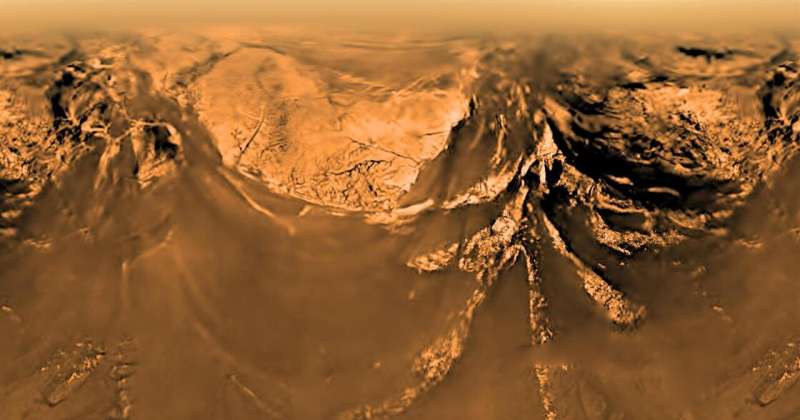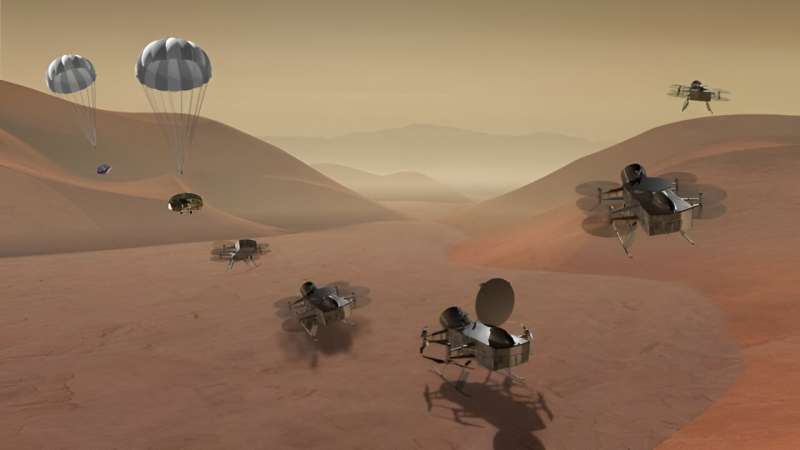
This image shows a flattened (Mercator) projection of the Huygens probe’s view of Saturn’s moon Titan from 10 kilometers altitude. The images that make up this view were taken on Jan. 14, 2005, with the descent imager/spectral radiometer onboard the European Space Agency’s Huygens probe. The Huygens probe was delivered to Titan by the Cassini spacecraft, managed by NASA’s Jet Propulsion Laboratory, Pasadena, Calif. Credit: ESA/NASA/JPL/University of Arizona photo
A study led by Western astrobiologist Catherine Neish shows the subsurface ocean of Titan—the largest moon of Saturn—is most likely a non-habitable environment, meaning any hope of finding life in the icy world is dead in the water.
This discovery means it is far less likely that space scientists and astronauts will ever find life in the outer solar system, home to the four ‘giant’ planets: Jupiter, Saturn, Uranus and Neptune.
“Unfortunately, we will now need to be a little less optimistic when searching for extraterrestrial lifeforms within our own solar system,” said Neish, an Earth sciences professor. “The scientific community has been very excited about finding life in the icy worlds of the outer solar system, and this finding suggests that it may be less likely than we previously assumed.”
The identification of life in the outer solar system is a significant area of interest for planetary scientists, astronomers and government space agencies like NASA, largely because many icy moons of the giant planets are thought to have large subsurface oceans of liquid water. Titan, for example, is thought to have an ocean beneath its icy surface that is more than 12 times the volume of Earth’s oceans.
“Life as we know it here on Earth needs water as a solvent, so planets and moons with lots of water are of interest when looking for extraterrestrial life,” said Neish, a member of Western’s Institute for Earth and Space Exploration.
In the study, published in the journal Astrobiology, Neish and her collaborators attempted to quantify the amount of organic molecules that could be transferred from Titan’s organic-rich surface to its subsurface ocean, using data from impact cratering.
Comets impacting Titan throughout its history have melted the surface of the icy moon, creating pools of liquid water that have mixed with the surface organics. The resulting melt is denser than its icy crust, so the heavier water sinks through the ice, possibly all the way to Titan’s subsurface ocean.
Using the assumed rates of impacts on Titan’s surface, Neish and her collaborators determined how many comets of different sizes would strike Titan each year over its history. This allowed the researchers to predict the flow rate of water carrying organics that travel from Titan’s surface to its interior.
Neish and the team found the weight of organics transferred in this way is quite small, no more than 7,500 kg/year of glycine—the simplest amino acid, which makes up proteins in life. This is approximately the same mass as a male African elephant. (All biomolecules, like glycine, use carbon—an element—as the backbone of their molecular structure.)
“One elephant per year of glycine into an ocean 12 times the volume of Earth’s oceans is not sufficient to sustain life,” said Neish. “In the past, people often assumed that water equals life, but they neglected the fact that life needs other elements, in particular carbon.”
Other icy worlds (like Jupiter’s moons Europa and Ganymede and Saturn’s moon Enceladus) have almost no carbon on their surfaces, and it is unclear how much could be sourced from their interiors. Titan is the most organic-rich icy moon in the solar system, so if its subsurface ocean is not habitable, it does not bode well for the habitability of other known icy worlds.
“This work shows that it is very hard to transfer the carbon on Titan’s surface to its subsurface ocean—basically, it’s hard to have both the water and carbon needed for life in the same place,” said Neish.

An artist’s rendering shows a Dragonfly quadcopter landing on the surface of Saturn’s moon Titan, unfolding its rotors and lifting off again to survey the landscape and atmosphere. Credit: Steve Gribben/Johns Hopkins
Flight of the Dragonfly
Despite the discovery, there is still much more to learn about Titan, and for Neish, the big question is, what is it made of?
Neish is a co-investigator on the NASA Dragonfly project, a planned 2028 spacecraft mission to send a robotic rotorcraft (drone) to the surface of Titan to study its prebiotic chemistry, or how organic compounds formed and self-organized for the origin of life on Earth and beyond.
“It is nearly impossible to determine the composition of Titan’s organic-rich surface by viewing it with a telescope through its organic-rich atmosphere,” said Neish. “We need to land there and sample the surface to determine its composition.”
To date, only the Cassini–Huygens international space mission in 2005 has successfully landed a robotic probe on Titan to analyze samples. It remains the first spacecraft to land on Titan and the farthest landing from Earth a spacecraft has ever made.
“Even if the subsurface ocean isn’t habitable, we can learn a lot about prebiotic chemistry on Titan, and Earth, by studying the reactions on Titan’s surface,” said Neish. “We’d really like to know if interesting reactions are occurring there, especially where the organic molecules mix with liquid water generated in impacts.”
Credit: JPL
When Neish started her latest study, she was worried it would negatively impact the Dragonfly mission, but it has actually led to even more questions.
“If all the melt produced by impacts sinks into the ice crust, we wouldn’t have samples near the surface where water and organics have mixed. These are regions where Dragonfly could search for the products of those prebiotic reactions, teaching us about how life may arise on different planets,” said Neish.
“The results from this study are even more pessimistic than I realized with regards to the habitability of Titan’s surface ocean, but it also means that more interesting prebiotic environments exist near Titan’s surface, where we can sample them with the instruments on Dragonfly.”
More information:
Catherine Neish et al, Organic Input to Titan’s Subsurface Ocean Through Impact Cratering, Astrobiology (2024). DOI: 10.1089/ast.2023.0055
Citation:
Saturn’s largest moon most likely uninhabitable (2024, February 14)
retrieved 14 February 2024
from https://phys.org/news/2024-02-saturn-largest-moon-uninhabitable.html
This document is subject to copyright. Apart from any fair dealing for the purpose of private study or research, no
part may be reproduced without the written permission. The content is provided for information purposes only.
>>> Read full article>>>
Copyright for syndicated content belongs to the linked Source : Phys.org – https://phys.org/news/2024-02-saturn-largest-moon-uninhabitable.html































